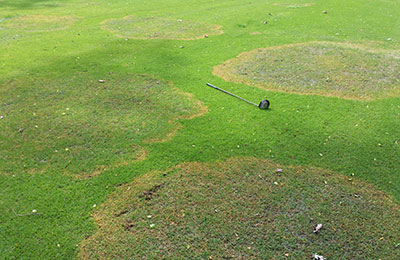Chemicals control large patch, depending on deposition

Seasonal large patch epidemics disrupt the uniformity of golf course turf.
Seasonal large patch (Rhizoctonia solani) epidemics are observed on zoysiagrass fairways in Tennessee each spring and fall. Golf courses with a history of large patch often will budget for two to three fairway fungicide applications. However, disease breakthrough commonly is observed despite the use of fungicides.
One possible explanation for this is poor fungicide deposition in the lower plant canopy, where infection occurs. Our objective was to determine the amount of protection provided by fungicides deposited on either the upper or lower plant canopy. Greenhouse experiments were conducted in 2015 in Knoxville, Tenn., to evaluate large patch control using fungicides applied on the stem, sheath or leaf parts of zoysiagrass. The fungicides Heritage (azoxystrobin, Syngenta), Prostar (flutolanil, Bayer), Torque (tebuconazole, Nufarm) and Daconil Ultrex (chlorothalonil, Syngenta) were applied at the high-labeled rate using a pipette to dispense a single coarse droplet on the leaf, sheath or stem.
Zoysiagrass plants were inoculated with Rhizoctonia solani and kept in a humid growth chamber. Measurements of visual disease severity (0-100 percent) were collected every seven days. On most rating dates, zoysiagrass treated with fungicides applied on the sheath or stem exhibited significantly lower large patch severity compared to applications on the leaf. Large patch control using Heritage, a xylem mobile fungicide, was most affected by the site of application. At 28 days after treatment, leaf applications of Heritage exhibited 74-percent disease severity, whereas the sheath and stem applications exhibited less than 5-percent disease severity. Daconil Ultrex, a contact fungicide, was least affected by the site of target application. In summary, all fungicides we tested exhibited significantly better large patch control when deposited lower in the plant canopy. Research is being conducted to develop strategies that improve fungicide penetration and deposition in the field. The use of higher spray rates (2 to 4 gallons per 1,000 ft2) and the incorporation of super-spreading surfactants may help distribute the fungicide solution lower in the plant canopy.
Jesse J. Benelli is a Ph.D. candidate, and Brandon Horvath, Ph.D., is a turfgrass pathologist at the University of Tennessee-Knoxville. You may reach Jesse Benelli at jbenelli@vols.utk.edu for more information.
Acknowledgment: The authors wish to acknowledge the USGA and WinField Solutions for funding this research. They would also like to thank golf course superintendents Trey Cutshall (the Farm Golf Club) and Jeff Dudych (Gettysvue Golf and Polo Club) for participating in the field research.
photo by: Jesse Benelli








